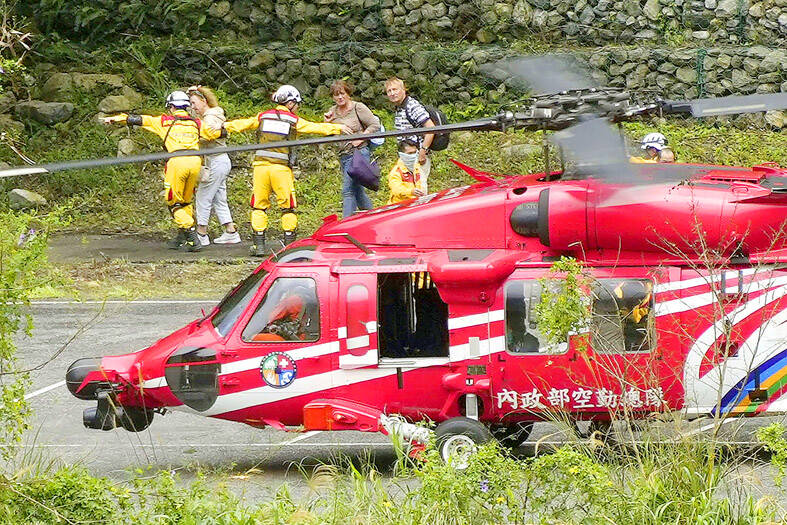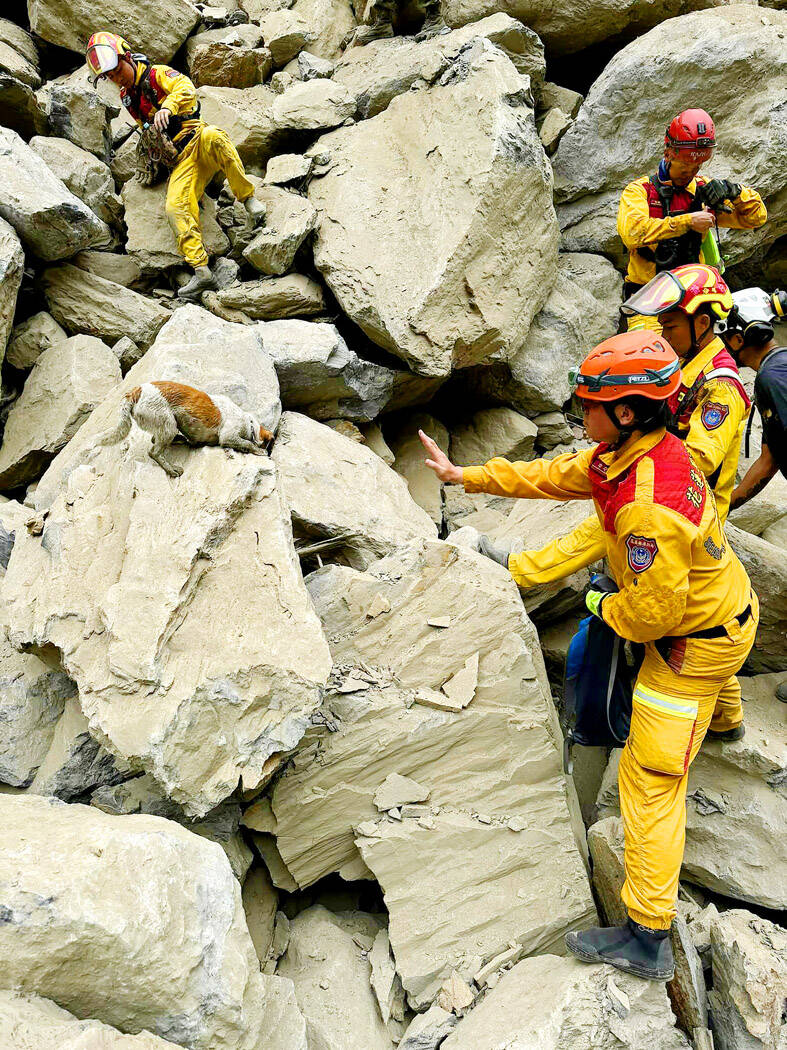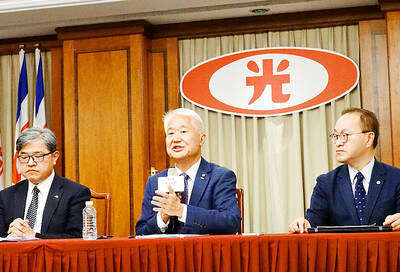The number of people confirmed dead after Wednesday’s massive earthquake has risen to 13 following the discovery of a woman in Hualien County yesterday and the confirmation of two bodies found on Friday, the Central Emergency Operations Center said, as rescuers continued to airlift trapped people in Hualien County.
The three deceased were among six people reported missing on Taroko National Park’s Shakadang Trail (砂卡礑).
The body of a 21-year-old woman surnamed Hu (胡), who traveled to Hualien alone, was found at the 0.5km mark on the trail at about 11am yesterday. An identification card was found on her body.

Photo: Suo Takekuma, Kyodo News via AP
It was earlier believed that the body could be that of another woman, who, along with her husband, surnamed Yu (游), and three children, were on the trail at the time of the quake.
Rescue personnel found the two other bodies on the trail on Friday, but they were not included in the official death toll until yesterday.
Yu’s mother said they were her son and 11-year-old granddaughter, but they have not been formally identified.

Photo courtesy of the Hualien Fire Department
Yu’s wife, eight-year-old son and five-year-old daughter could be buried more than 25m below the trail, rescue personnel said, adding that aftershocks and inclement weather have affected the rescue mission.
As of 2:30pm yesterday, 13 people had died and 1,145 were injured in the earthquake, while 405 were trapped or stranded and six were missing, data released by the center showed.
As of 10am — 74 hours after the temblor, which measured 7.2 on the Richter scale and magnitude 7.4 on the moment magnitude scale — the Central Weather Administration had recorded 603 aftershocks, including 23 that were magnitude 5 or greater.
The aftershocks have loosened earth, causing rocks to continue falling intermittently.
Demolition of a building in Hualien City that was leaning precariously after the quake was also halted, because of aftershocks that caused it to lean further.
Meanwhile, National Airborne Service Corps helicopters flew to areas that had been cut off near Taroko National Park to airlift stranded people.
“Priority was given to the elderly, the weak, women, children and people with chronic diseases,” news Web site ET Today reported. “Although everyone was tired after coming down the mountain, they were all still smiling.”
One airlift brought people from the luxury Silks Place Taroko (太魯閣晶英酒店) hotel, where more than 400 tourists and staff had been stranded.
Rescuers also airdropped boxes of food and supplies to a group of students, teachers and residents at an inaccessible elementary school.
Elsewhere, engineers were working around the clock to clear massive boulders from roads and tunnel entrances.
Minister of the Interior Lin Yu-chang (林右昌) said that Taiwan would bolster its rescue operations by working with a team of experts from Turkey.
Seven Turkish rescuers arrived in Taiwan last night and brought with them drone technology to assist in the rescue efforts due to the challenging terrain in the area, said Lin, who also heads the Central Emergency Operation Center.
Other than the drones, local rescue capabilities and resources are plentiful, he said, adding that the Turkish team is the only foreign rescue team Taiwan has accepted technical assistance from.

People can preregister to receive their NT$10,000 (US$325) cash distributed from the central government on Nov. 5 after President William Lai (賴清德) yesterday signed the Special Budget for Strengthening Economic, Social and National Security Resilience, the Executive Yuan told a news conference last night. The special budget, passed by the Legislative Yuan on Friday last week with a cash handout budget of NT$236 billion, was officially submitted to the Executive Yuan and the Presidential Office yesterday afternoon. People can register through the official Web site at https://10000.gov.tw to have the funds deposited into their bank accounts, withdraw the funds at automated teller

PEACE AND STABILITY: Maintaining the cross-strait ‘status quo’ has long been the government’s position, the Ministry of Foreign Affairs said Taiwan is committed to maintaining the cross-strait “status quo” and seeks no escalation of tensions, the Ministry of Foreign Affairs (MOFA) said yesterday, rebutting a Time magazine opinion piece that described President William Lai (賴清德) as a “reckless leader.” The article, titled “The US Must Beware of Taiwan’s Reckless Leader,” was written by Lyle Goldstein, director of the Asia Program at the Washington-based Defense Priorities think tank. Goldstein wrote that Taiwan is “the world’s most dangerous flashpoint” amid ongoing conflicts in the Middle East and Russia’s invasion of Ukraine. He said that the situation in the Taiwan Strait has become less stable

CONCESSION: A Shin Kong official said that the firm was ‘willing to contribute’ to the nation, as the move would enable Nvidia Crop to build its headquarters in Taiwan Shin Kong Life Insurance Co (新光人壽) yesterday said it would relinquish land-use rights, or known as surface rights, for two plots in Taipei’s Beitou District (北投), paving the way for Nvidia Corp to expand its office footprint in Taiwan. The insurer said it made the decision “in the interest of the nation’s greater good” and would not seek compensation from taxpayers for potential future losses, calling the move a gesture to resolve a months-long impasse among the insurer, the Taipei City Government and the US chip giant. “The decision was made on the condition that the Taipei City Government reimburses the related

FRESH LOOK: A committee would gather expert and public input on the themes and visual motifs that would appear on the notes, the central bank governor said The central bank has launched a comprehensive redesign of New Taiwan dollar banknotes to enhance anti-counterfeiting measures, improve accessibility and align the bills with global sustainability standards, Governor Yang Chin-long (楊金龍) told a meeting of the legislature’s Finance Committee yesterday. The overhaul would affect all five denominations — NT$100, NT$200, NT$500, NT$1,000 and NT$2,000 notes — but not coins, Yang said. It would be the first major update to the banknotes in 24 years, as the current series, introduced in 2001, has remained in circulation amid rapid advances in printing technology and security standards. “Updating the notes is essential to safeguard the integrity